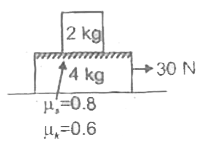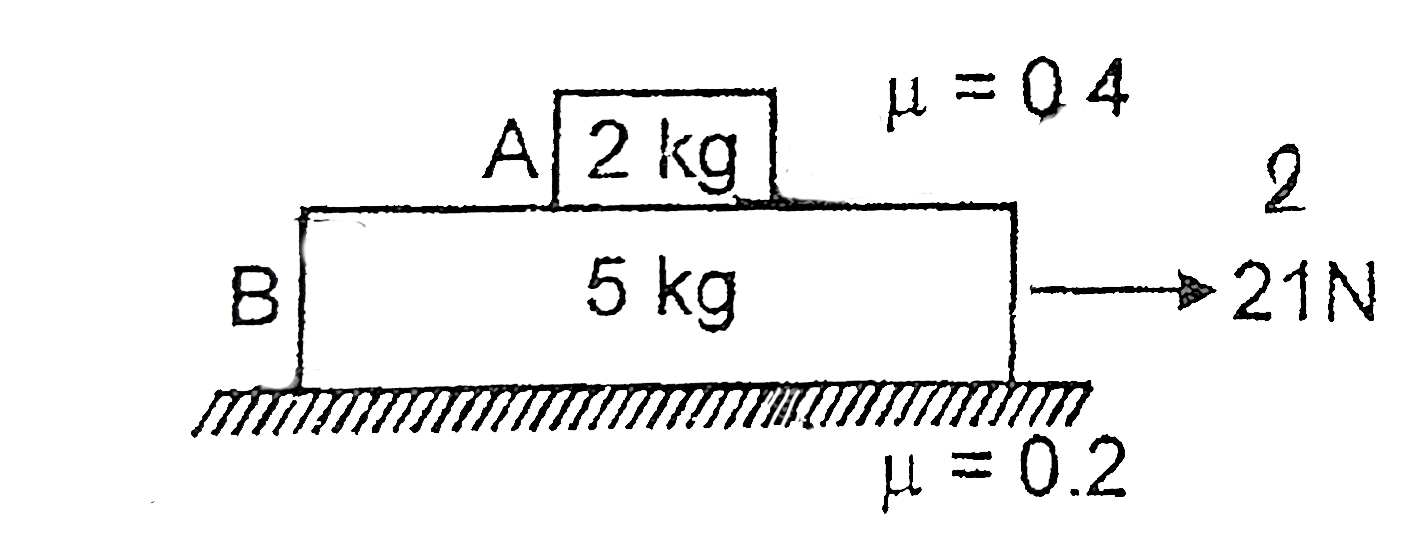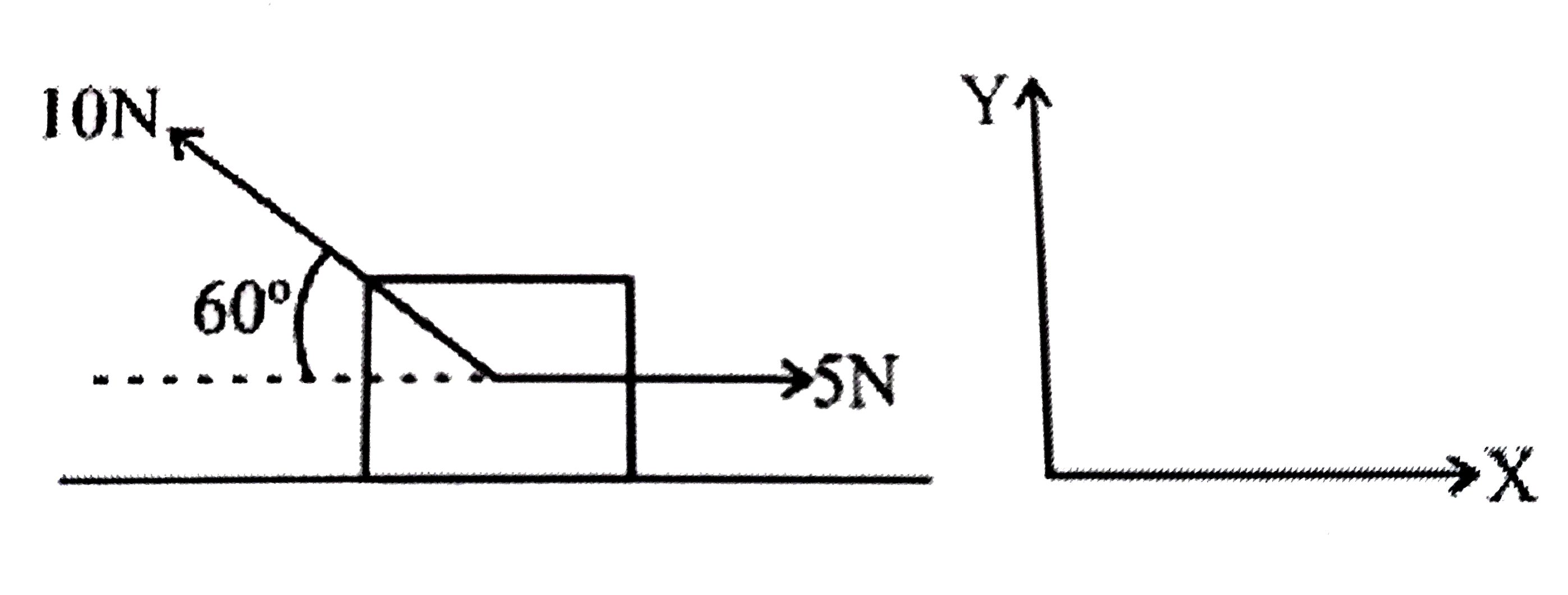A horizontal force of 4 N is applied to a block of mass 2 kg resting on a frictionless table. What is the acceleration of the block in ?
The correct Answer is:2
To find the acceleration of the block when a horizontal force is applied, we can use Newton's second law of motion, which states that the force acting on an object is equal to the mass of the object multiplied by its acceleration. This can be expressed with the formula:
F=m⋅a
Where:
- F is the force applied (in Newtons),
- m is the mass of the object (in kilograms),
- a is the acceleration (in meters per second squared).
1. Identify the Given Values:
- Force (F) = 4 N
- Mass (m) = 2 kg
2. Use Newton's Second Law:
According to Newton's second law, we can rearrange the formula to solve for acceleration (a):
a=Fm
3. Substitute the Values:
Now, substitute the values of force and mass into the equation:
a=4N2kg
4. Calculate the Acceleration:
Perform the division:
a=2m/s2
5. Conclusion:
The acceleration of the block is 2m/s2.
- F is the force applied (in Newtons),
- m is the mass of the object (in kilograms),
- a is the acceleration (in meters per second squared).
- Force (F) = 4 N
- Mass (m) = 2 kg
According to Newton's second law, we can rearrange the formula to solve for acceleration (a):
a=Fm
Now, substitute the values of force and mass into the equation:
a=4N2kg
Perform the division:
a=2m/s2
The acceleration of the block is 2m/s2.
Topper's Solved these Questions
- BOOK - MTG IIT JEE FOUNDATIONCHAPTER - FORCE AND PRESSURE EXERCISE - OLYMPIAD/HOTS CORNER15videos
FORCE AND PRESSURE
- BOOK - MTG IIT JEE FOUNDATIONCHAPTER - FORCE AND PRESSURE EXERCISE - EXERCISE (SUBJECTIVE PROBLEMS LONG ANSWER TYPE)5videos
FORCE AND PRESSURE
- BOOK - MTG IIT JEE FOUNDATIONCHAPTER - FOOTSTEPS TOWARDS NEETEXERCISE - MCQ45videos
FOOTSTEPS TOWARDS NEET
- BOOK - MTG IIT JEE FOUNDATIONCHAPTER - FRICTION EXERCISE - OLYMPIAD/HOTS CORNER15videos
FRICTION
Similar Questions
Two blocks of masses 10 kg and 20 kg are connected by a massless spring and are placed on a smooth horizontal surface. A force of 200 N is applied on 20 kg mass as shown in the diagram. At the instant, the acceleration of 10 kg mass is 12ms−2, the acceleration of 20 kg mass is:
 View Solution
View SolutionA block of mass 2kg is placed on a trolley of mass 20 kg free to move on a frictionless floor. What are the frictional force, accelerations of the block and trolley if the block is pulled by a force of 3 N ? The coefficient of friction between block and trolley is 0.25. What will be the values of all three if the block is pulled by 8 N force ? At what value of the applied force will the bodies just tend to separate ?
[Hint : So long as the force applied does not produce the limiting frictional force the two will move with common acceleration. When the force applied exceeds that limiting value the block will move on the trolley with a different acceleration]View Solution
Knowledge Check
- Question 1 - Select One
Block A of mass 35 kg is resting on a frictionless floor.
 A0.8ms−2B2.4ms−2C0.4ms−2D4.4ms−2
A0.8ms−2B2.4ms−2C0.4ms−2D4.4ms−2 - Question 2 - Select One
A horizontal force of 20 N i sapplied to a block of mass 4 kg resting on a rough horiozontal table. If the blcok does not move on the table, how much fricrtional force the table is applying on the blockgt What can be said about the coefficient of static friction between the block and the table? Takeg=ms2.
A-20 N , greater than 0.5B-20 N , less than 0.5C-40 N , greater than 0.5D-50 N , equal to 0.5 - Question 3 - Select One
A horizontal force of 20 N is applied to a block of 10 kg resting on a rough horizontal surface. How much additional force is required to just move the block, if the coefficient of static friction between the block and the surface is 0.4 ?
A15.5 NB10.3 NC8.5 ND19.2 N
Figure shows two block system, 4 kg block rests on a smooth horizontal surface, upper surface of 4 kg is rough. A block of mass 2 kg is placed on its upper surface. The acceleration of upper block with respect to earth when 4 kg mass is pulled by a force of 30 N, is
 View Solution
View SolutionA block B of mass 5kg rests on a rough horizontal surface (μ=0.2),A block A of mass 2kg rests on block B(μ=0.4). If a horizontal force of 21 N be applied to the block B, what is force (in N) of friction acting between the blocks A and B ? (g=10ms−2)
 View Solution
View SolutionTwo blocks of masses M = 3 kg and m = 2 kg are in contact on a horizontal table. A constant horizontal force F = 5 N is applied to block M as shown. There is a constant frictional force of 2 N between the table and the block m but no frictional force between the table and the first block M, then acceleration of the two blocks is
 View Solution
View SolutionTwo blocks of masses M = 3 kg and m = 2 kg, are in contact on a horizontal table. A constant horizontal force F = 5 N is applied to block M as shown. There is a constant frictional force of 2 N between the table and the block m but no frictional force between the table and the first block M, then the acceleration of the two blocks is-
View SolutionA block of mass √3kg rests on a horizontal frictionless surface. What will be the acceleration of the block if it is subjected to two forces as shown in the figure.
 View Solution
View Solution

